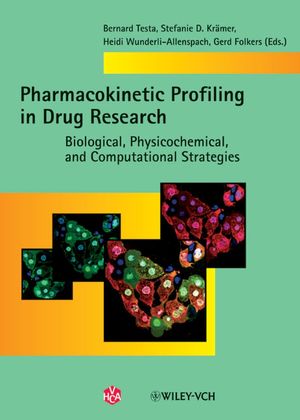Pharmacokinetic Profiling in Drug Research: Biological, Physicochemical, and Computational StrategiesISBN: 978-3-90639-035-2
Hardcover
500 pages
March 2006
 |
||||||
Informatics and robotics are the workhorses of a technological revolution in drug research. On them are based combinatorial chemistry, which yields compounds by the many thousands, and high-throughput bioassays, which screen them for activity. The results are avalanches of 'hits', which invade the databases like swarms of locusts. But far from being a plague, these innumerable compounds become a blessing if properly screened for 'drugability', i.e., for 'drug-like' properties such as good pharmacokinetic (PK) behavior. Pharmacokinetic profiling of bioactive compounds has, thus, become a sine qua non condition for cherry-picking the most promising hits. Just as important, but less visible, are the structure-property and structure-ADME relations, which emerge from PK profiling and provide useful feedback when designing new synthetic series. As a result, the screening, design, and optimization of pharmacokinetic properties has become the bottleneck and a major challenge in drug research. To shorten the time-consuming development and high rate of attrition of active compounds ultimately doomed by hidden pharmacokinetic defects, powerful biological, physicochemical, and computational approaches are being developed, whose objectives are to increase the clinical relevance of drug design and to eliminate as soon as possible compounds with unfavorable physicochemical properties and pharmacokinetic profiles.
The profiling of ADME properties (absorption, distribution, metabolism, and excretion) is the topic of this book. Following the extraordinary success of the previous work ('Pharmacokinetic Optimization in Drug Research: Biological, Physicochemical, and Computational Strategies', Eds. B. Testa, H. van de Waterbeemd, G. Volkers, R. Guy, Verlag Helvetica Chimica Acta, Zurich, 2001, 655 pages), there was a need for an essentially new edition focusing on the latest theoretical and technological breakthroughs. In this unique work, international authorities and practicing experts from academia and industry offer state-of-the-art presentations of concepts, methods and technologies now in use or development in drug research. The biological strategies emphasized in the book include cell cultures, drug-metabolizing enzymes, transporters and plasma protein binding. The physicochemical strategies focus on artificial membrane-permeability assays, on solubility and lipophilicity and related molecular properties as factors and predictors of pharmacokinetic behavior, and on stability and solid-state properties. Computational strategies comprize the exploration of property spaces, pharmacophore searching to predict biotransformation and enzyme inhibition, and expert systems to process biopharmaceutical profiling data.
In addition to its 28 chapters, the book includes a CD-ROM containing the invited lectures, oral communications, and posters (in full version) presented at the Third LogP Symposium, 'Physicochemical and Biological Profiling in Drug Research', held at the Federal Institute of Technology (ETH) of Zurich in March 2004.
The profiling of ADME properties (absorption, distribution, metabolism, and excretion) is the topic of this book. Following the extraordinary success of the previous work ('Pharmacokinetic Optimization in Drug Research: Biological, Physicochemical, and Computational Strategies', Eds. B. Testa, H. van de Waterbeemd, G. Volkers, R. Guy, Verlag Helvetica Chimica Acta, Zurich, 2001, 655 pages), there was a need for an essentially new edition focusing on the latest theoretical and technological breakthroughs. In this unique work, international authorities and practicing experts from academia and industry offer state-of-the-art presentations of concepts, methods and technologies now in use or development in drug research. The biological strategies emphasized in the book include cell cultures, drug-metabolizing enzymes, transporters and plasma protein binding. The physicochemical strategies focus on artificial membrane-permeability assays, on solubility and lipophilicity and related molecular properties as factors and predictors of pharmacokinetic behavior, and on stability and solid-state properties. Computational strategies comprize the exploration of property spaces, pharmacophore searching to predict biotransformation and enzyme inhibition, and expert systems to process biopharmaceutical profiling data.
In addition to its 28 chapters, the book includes a CD-ROM containing the invited lectures, oral communications, and posters (in full version) presented at the Third LogP Symposium, 'Physicochemical and Biological Profiling in Drug Research', held at the Federal Institute of Technology (ETH) of Zurich in March 2004.



